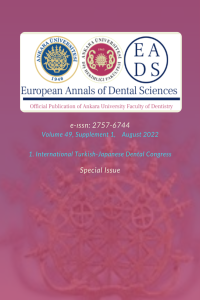Abstract
Aim: To determine adiponectin and leptin expression levels in samples from healthy, dysplastic and cancerous oral lesions and to investigate the potential role of these biomarkers in oral cancer development.
Methods: Tissue samples from the archives which were histologically diagnosed as oral squamous cell carcinoma (OSCC) (n=24), oral dysplasia (n=12) and healthy tissue (n=16) were included. The concentration and purity of samples were determined after total RNA extraction. Thereafter, cDNA synthesis was performed. The differences between expression levels were evaluated with qPCR. Expression levels related to OSCC were performed according to normalizing gene ACTB. 2-ΔΔCT method was used for comparison of expression levels. Student t-test was used to compare the differences in gene expression levels between groups, using 2-ΔΔCT value for each gene.
Results: Adiponectin and leptin expression levels were decreased by 1.09 (p = 0.49) and 10.3 (p = 0.22), respectively, in OSCC group, however differences were not statistically significant. The level of adiponectin expression decreased by 1.65 times (p = 0.62) and leptin expression increased by 3 times (p = 0.30) in the dysplasia group. When OSCC and dysplasia groups were compared, it was found that the level of adiponectin expression increased by 1.52 times (p = 0.99) and the level of leptin expression decreased by 30.94 times (p = 0.16) in the OSCC group. The samples were re-grouped as increased risk (OSCC+dysplasia) (n=36) and healthy (n=16) and a decrease by 16.5 (p= 0.3) in leptin expression and an increase by 1.14 (p= 0.6) in adiponectin expression was observed in the increased risk group compared to the healthy group.
Conclusion: In tissue samples diagnosed as healthy, dysplastic and OSCC, expression levels for leptin and adiponectin have not been compared before. The results revealed a significant decrease in leptin expression and an increase in adiponectin expression in increased risk group.
Supporting Institution
Ege University, Scientific Research Projects Coordination
Project Number
BAP 18-Diş 008
References
- 1. Galvão-Moreira LV, da Cruz MCFN. Screening and early detection of oral cancer: Current controversies. Acta Odontol Scand 2017;75(5):361-5.
- 2. Epstein JB, Zhang L, Rosin M. Advances in the diagnosis of oral premalignant and malignant lesions. J Can Dent Assoc 2002;68(10):617-21.
- 3. Scully C, Bagan J. Oral squamous cell carcinoma overview. Oral Oncology 2009;45(4-5):301–8.
- 4. Inal E, Laçin M, Asal K et al. The significance of ferritin, lipid-associated sialic acid, CEA, squamous cell carcinoma (SCC) antigen, and CYFRA 21-1 levels in SCC of the head and neck. Kulak Burun Bogaz Ihtis Derg. 2004;12:23-30.
- 5. Carreras-Torras C, Gay-Escoda C. Techniques for early diagnosis of oral squamous cell carcinoma: Systematic review. Med Oral Patol Oral Cir Bucal 2015;20 (3):305-15.
- 6. Lingen MW, Pinto A, Mendes RA et al. Genetics/epigenetics of oral premalignancy: Current status and future research. Oral Dis 2011;17:7-22.
- 7. Fasshauer M, Blüher M. Adipokines in health and disease. Trends Pharmacol Sci. 2015 Jul;36(7):461-70. doi: 10.1016/j.tips.2015.04.014.
- 8. Young MR, Levingston C, Johnson SD. Cytokine and Adipokine Levels in Patients with Premalignant Oral Lesions or in Patients with Oral Cancer Who Did or Did Not Receive 1α,25-Dihydroxyvitamin D3 Treatment upon Cancer Diagnosis. Cancers (Basel). 2015;25;7(3):1109-24.
- 9. Guo XH, Wang JY, Gao Y et al. Decreased adiponectin level is associated with aggressive phenotype of tongue squamous cell carcinoma. Cancer Sci 2013;104:206-13.
- 10. Yapijakis C, Kechagiadakis M, Nkenke E et al. Association of leptin -2548G/A and leptin receptor Q223R polimorphisms with increased risk for oral cancer. J Cancer Res Clin Oncol. 2009;135(4):603-12.
Abstract
Project Number
BAP 18-Diş 008
References
- 1. Galvão-Moreira LV, da Cruz MCFN. Screening and early detection of oral cancer: Current controversies. Acta Odontol Scand 2017;75(5):361-5.
- 2. Epstein JB, Zhang L, Rosin M. Advances in the diagnosis of oral premalignant and malignant lesions. J Can Dent Assoc 2002;68(10):617-21.
- 3. Scully C, Bagan J. Oral squamous cell carcinoma overview. Oral Oncology 2009;45(4-5):301–8.
- 4. Inal E, Laçin M, Asal K et al. The significance of ferritin, lipid-associated sialic acid, CEA, squamous cell carcinoma (SCC) antigen, and CYFRA 21-1 levels in SCC of the head and neck. Kulak Burun Bogaz Ihtis Derg. 2004;12:23-30.
- 5. Carreras-Torras C, Gay-Escoda C. Techniques for early diagnosis of oral squamous cell carcinoma: Systematic review. Med Oral Patol Oral Cir Bucal 2015;20 (3):305-15.
- 6. Lingen MW, Pinto A, Mendes RA et al. Genetics/epigenetics of oral premalignancy: Current status and future research. Oral Dis 2011;17:7-22.
- 7. Fasshauer M, Blüher M. Adipokines in health and disease. Trends Pharmacol Sci. 2015 Jul;36(7):461-70. doi: 10.1016/j.tips.2015.04.014.
- 8. Young MR, Levingston C, Johnson SD. Cytokine and Adipokine Levels in Patients with Premalignant Oral Lesions or in Patients with Oral Cancer Who Did or Did Not Receive 1α,25-Dihydroxyvitamin D3 Treatment upon Cancer Diagnosis. Cancers (Basel). 2015;25;7(3):1109-24.
- 9. Guo XH, Wang JY, Gao Y et al. Decreased adiponectin level is associated with aggressive phenotype of tongue squamous cell carcinoma. Cancer Sci 2013;104:206-13.
- 10. Yapijakis C, Kechagiadakis M, Nkenke E et al. Association of leptin -2548G/A and leptin receptor Q223R polimorphisms with increased risk for oral cancer. J Cancer Res Clin Oncol. 2009;135(4):603-12.
Details
| Primary Language | English |
|---|---|
| Subjects | Dentistry |
| Journal Section | Conference Papers |
| Authors | |
| Project Number | BAP 18-Diş 008 |
| Publication Date | August 31, 2022 |
| Submission Date | August 20, 2021 |
| Published in Issue | Year 2022 Volume: 49 Issue: Suppl 1 |


